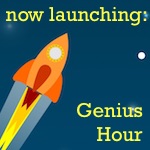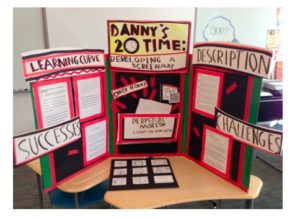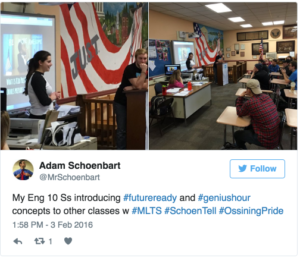1% teacher inspiration & 99% student-led
 Genius Hour is a leap of faith in which educators set aside their most precious resource, time, for students to pursue their passions. It doesn’t get much more student-centered than that.
Genius Hour is a leap of faith in which educators set aside their most precious resource, time, for students to pursue their passions. It doesn’t get much more student-centered than that.
But there are actually several aspects of Genius Hour where students can be involved as partners to amp up the genius quotient.
Why partner with students for Genius Hour?
Genius Hour is so much different than the way that most teachers experienced school that as a teacher, it is almost impossible to avoid an instinctual inner backlash. As you turn students loose the first time you will constantly be hearing an inner voice saying things like “add structure,” “be a real teacher,” “rein these kids in.”
Ignore that inner voice! (In favor of student voice.)
This is your chance to fully embrace student engagement and ownership. An immersive and empowering Genius Hour experience can move the needle on the overall culture of your school.
So here’s four suggestions for fully enlisting students as partners in Genius Hour.
1. Marketing
An oft overlooked but critical part of a successful Genius Hour experience is the marketing. Students are geniuses at building anticipation and excitement.
Crossett Brook Middle School in Waterbury, Vermont launched their first Genius Hour with a student-led campaign that included branding, mysterious signage, and a video.
[youtube https://www.youtube.com/watch?v=qO8MTm7o_E0]
Just having students introduce the project shifts the perspective.
2. Minimal requirements
Embarking on open-ended projects can be scary and there is a temptation to provide students with detailed and tight parameters to make sure that nobody is left flailing.
As the well-intentioned structures pile up (templates, deadlines, upfront planning) you run the risk that some of your geniuses won’t be able to get past the scaffolding in order to paint their masterpiece.
For Crossett Brook Middle School’s Brainado project, they really only had one major requirement: students must share something. From that one overarching principle a lot of other things flowed, such as defining some kind of deliverable that counted as “something,” but it gave room for student creativity to thrive.
And I’m not saying that having some check-ins or milestones is a bad idea. Just beware of paperwork and benchmark overload. There is no substitute for the attention and direct feedback of conferencing with students.
3. Self-assessment
Personalized learning engages students as partners in assessment, whether they are cultivating evidence of goal progress on a Personalized Learning Plan or examining their growth using a proficiency scale.
Genius Hour is a great place to set aside teacher-given grades and rely on student reflection and self-assessment.
There are a lot of tools and templates floating around, such as the Genius Hour Self-Assessment Rubric, but it this is also a good opportunity to have students co-construct the rubric.
4. Organize the exhibition of work
At the end of a Genius Hour experience it is important for students to share their projects, products, and learnings. This is a celebration where student voice and leadership are amplified.
Students can partner in the planning of the event, organize the physical spaces and signage, act as greeters and MCs during the event itself, and document the excitement via photos, videos, and social media as appropriate.




One Reply to “4 ways to partner with students around Genius Hour”
Comments are closed.